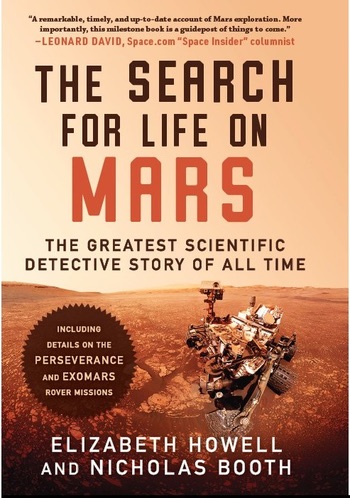Review: The Search for Life on Marsby Jeff Foust
|
| Much of the book is familiar ground for many readers, but is still interesting particularly as it’s driven by the people involved with the past and future of Mars exploration. |
Mars has long captured the attention of scientists, not to mention the budgets of space agencies, in large part because of its potential to have once hosted life or perhaps still host life today. Samples that Mars 2020 collects and are later brought back to Earth will be studied by scientists looking for evidence of past life, while Europe’s ExoMars mission—delayed from 2020 to 2022 by technical issues exacerbated by the coronavirus pandemic—will also look for signs of life, including drilling up to two meters into the surface where conditions may be more habitable. There are, of course, many other scientific questions involving Mars that have nothing to do with the search for life, but it’s unlikely that the planet wouldn’t be getting so much attention (too much, some scientists might complain) without that astrobiological interest.
That long history of, and future prospects for, seeking life on Mars is the subject of The Search for Life on Mars by Elizabeth Howell and Nicholas Booth. The book makes use of extensive interviews over the years with many of the key scientists involved with Mars missions to examine those missions and other efforts to determine if there was, or still is, some kind of life on the Red Planet.
The book meanders through that history, rather than taking a straight chronological approach. An early chapter, for example, examines the InSight lander mission, which isn’t directly involved with the search for life (although understanding the geophysics of the Martian interior may help refine models of the planet’s early history, when it was potentially more habitable.) A later chapter goes back to Percival Lowell and his observations of Mars. Near the end, the book looks ahead to the upcoming missions and the prospects of returning samples from Mars.
Much of the book is familiar ground for many readers, but is still interesting particularly as it’s driven by the people involved with the past and future of Mars exploration. It profiles people like Donna Shirley, Michael Malin, and Adam Steltzner, among others, following their careers (Malin, for example, secured invitations to the launch of Apollo 11 and was in mission control for its landing, even though he was just a college student) as well as the missions and the scientific interest in the search for life. That human focus helps overcome the occasional error: Mars Observer launched on a Titan III, not a Titan IV, and NASA’s Langley Research Center is in Hampton, Virginia, rather than sharing Langley, Virginia, with CIA headquarters.
| “The discovery of life on Mars will be a defining moment in this century,” they write. Note the certainty: “will be,” not “might be” or “could be.” |
The authors of The Search for Life on Mars tend to be optimists in that search, favorably presenting past research that appeared to find evidence of life. Gil Levin and his Labeled Release experiment on the Viking landers get a sympathetic treatment, despite the fact that few other scientists today see that experiment’s findings as conclusive evidence of life on Mars. Another chapter recounts the saga of Martian meteorite ALH84001, which scientists said in 1996 showed evidence of past, primitive life. “Indeed, the jury is still out,” they write, even though the longstanding scientific consensus is that the features seen in ALH84001 can be explained by non-biological mechanisms. The jury is not still out; rather, it’s long been out of the courthouse.
That optimism extends to the book’s conclusion. “The discovery of life on Mars will be a defining moment in this century,” they write. Note the certainty: “will be,” not “might be” or “could be.” If the last several decades have taught us anything about the search for life on Mars, it’s how difficult it can be, with missteps, false alarms, and setbacks, such as those described in this book. Perhaps Perseverance and its sample return successors, or ExoMars, or future human missions, will one day uncover incontrovertible evidence of past or present life. But as the history of Mars exploration has amply demonstrated, that is no sure thing.
Note: we are temporarily moderating all comments submitted to deal with a surge in spam.
